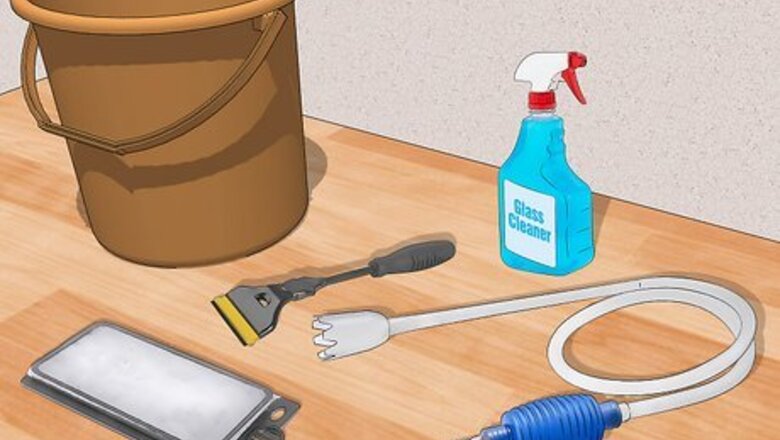
views
Freshwater Aquariums
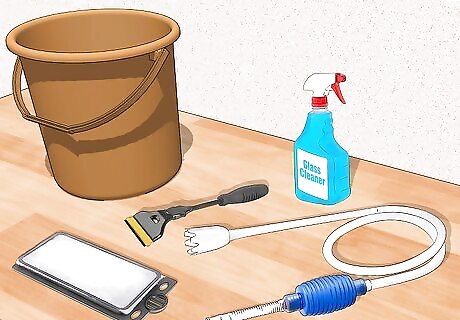
Get your cleaning supplies ready. Ensure that you have everything you need, including water conditioner, before you start the cleaning process. Run through your checklist and ensure that you've prepped your tools and your workspace. Properly prepared water in the quantity you'll need to replace or water conditioner to treat chlorinated tap water. An algae scraper for cleaning the glass inside the tank (scrubby pad, straightedge, or combination). A 5 US gal (19 L) bucket dedicated for this purpose. A simple siphon-type gravel vacuum (NOT a battery-operated gadget). Filter media (cartridges, sponges, carbon packets, and so on) if you're changing the filter this time. Aquarium-safe glass cleaner or a vinegar-based solution. ⁄4 cup (59 mL) of bleach per 3–4 US gal (11–15 l) of water in a separate container (optional). Metal or plastic razor blade (optional, be careful with acrylic tanks, as these scratch easier).
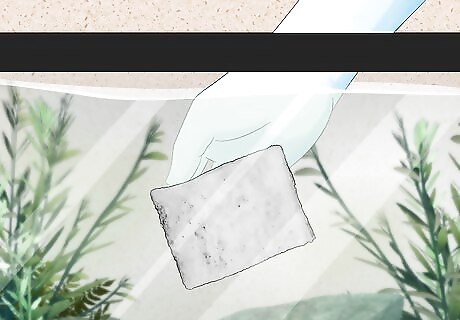
Start by cleaning the sides of the aquarium with the algae pad. Run it along the glass, scrubbing a little as necessary, to remove algae that are sticking to the aquarium. If you come across a particularly difficult patch of residue, use a razor blade or plastic blade to scrape it off the glass. You might want to wear aquarium gloves to complete this job, especially if you are allergic to anything in the tank (like a synthetic salt mix). Choose shoulder-length plastic gloves designed for use in aquariums. Do not just use the sponge or scrubber from your kitchen sink or anything that could have the residue of detergent or cleaning chemicals. A clean, tank-only algae pad will prevent harsh chemicals and detergents from getting into your tank. A magnetic glass cleaner is better to clean fish tank glass without wet hands. This step can also be done after you take out 10-20% of the water.
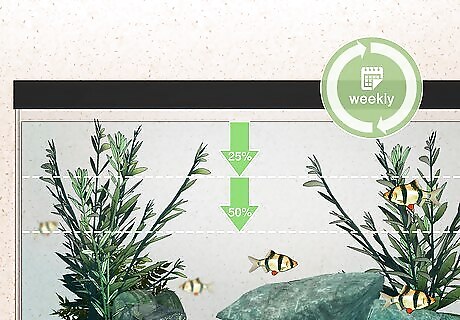
Decide how much water you are going to change. Consider the bio-load (i.e. the rate of nutrient accumulation) of your tank when determining how much water to change and how often to change it. Aim to change 25-50% of the water each week. If your goal is to reduce nitrate and phosphate to minimum levels, large, more frequent water changes are required. And, if you do larger water changes (50% or more), you can perform them less often. Note that a weekly 10% water change is inferior to a 40% change once per month.
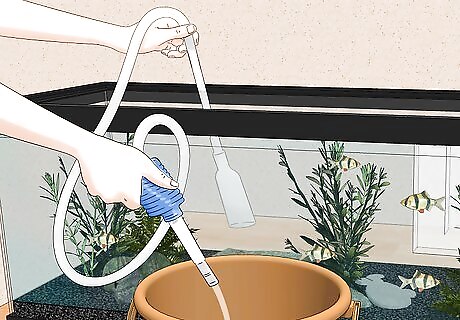
Siphon out the old water. Start the siphon and direct the old water into a pail, preferably a 5 US gal (19 L) bucket. It's best to buy a new bucket and use it only for cleaning your fish tank; this means no repurposing the laundry room bucket or the bucket that used to hold your dishwashing cleaning agents—synthetic detergent is toxic to fish. Aquarium siphons can be purchased that hook up to a sink. If you have one of these, read over the instructions on how they work. This type of siphon also prevents water spilling from the bucket. You can use the same hose to siphon and fill the tank. Use a hose with a small diameter if you want a gentler flow of water.
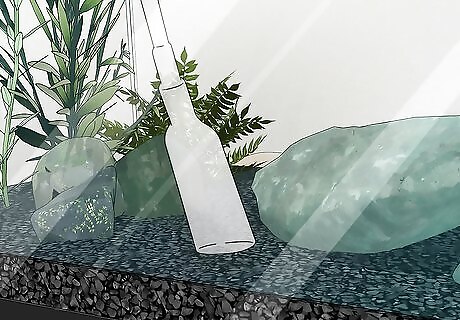
Clean the gravel. Push the gravel vacuum through the gravel. Fish waste, excess food, and other debris will be sucked into the vacuum. If you have very small, weak, or delicate fish, you can put a clean fishnet over the end of the siphon. Clean at least 25-30% of the gravel each month. If you have sand substrate, lower the flow rate by putting your finger over the end of the siphon or kinking the hose. Hold the hose 1 inch (2.5 cm) or less from the surface and use it suck up waste without disturbing your sand. Run your fingers through or stir the sand (provided there are no buried animals to disturb) to help release gunk trapped underneath it and prevent the formation of anaerobic zones.
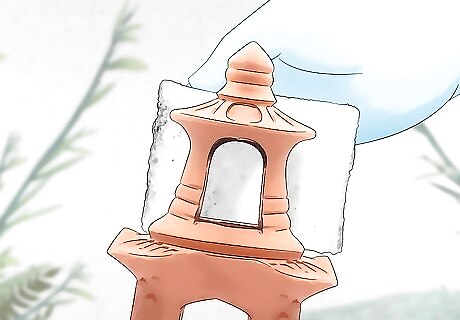
Clean the decorations. Algae is caused by nutrients in the water and light exposure, so it may build up on your tank decorations. You can wipe the decorations off with an algae pad or a never-used soft-bristled toothbrush in the tank water as you siphon. Avoid the use of soap; it could harm your fishy friend! If you're having difficulty cleaning the decorations, remove them from the tank and soak the items in a large bucket filled with water and ⁄4 cup (59 mL) of bleach for 15 minutes. Rinse the items thoroughly and treat them with chlorine water conditioner. If they are porous, let them dry completely before returning them to the tank. If you're having algae issues, lowering the nutrient accumulation or exposure to light will help. You can close your window coverings, move the tank away from a window, or adjust the lighting schedule. Alternatively, perform larger or more frequent water changes. Having a true flying fox, otocinclus, or rubber nose pleco in larger tanks can prevent algae from growing excessively.
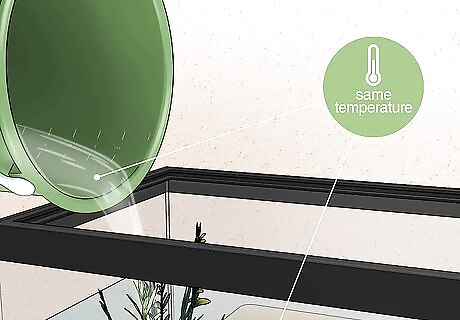
Add fresh water. Replace the water you took out with fresh, treated water at the temperature of the aquarium. An infrared thermometer is the best way to verify the temperature. Staying inside the dictated temperature parameters is crucial for the health of your fish. Remember, lukewarm is too hot for most fish. Avoid overfilling the tank. If you use tap or faucet water, conditioning the water to remove chlorine, heavy metals, and other toxins that your fish can't process is a must. Choose a conditioner with an ammonia detoxifier chemical. Plan ahead and fill a bucket the day before you perform the water change. Add the water conditioner and allow the water to sit overnight. Make sure that the water you refill the tank with is the same temperature as the water in the aquarium—a difference of more than 1 °F (−17 °C) is very dangerous for your fish. If the nitrates are astronomically high, you can do a water change with reverse osmosis water from your local fish store. Add a freshwater aquarium buffer to the water to keep your tank stable.
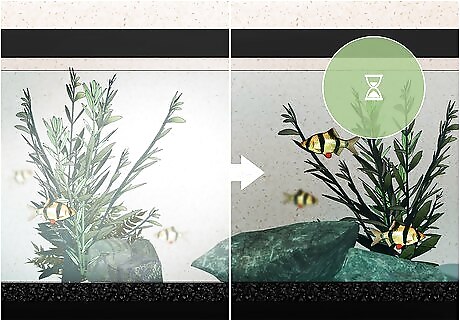
Watch the water. Wait a few hours for any cloudiness that remains to dissipate, leaving the water sparkling clear. Although there are water clearing agents on the market, they are usually unnecessary. If the water remains cloudy, it's because of an underlying problem and the agent will only mask (not solve) the issue.

Clean the exterior. Wipe down the outside, including the glass, hood, light, and tank top. You can use glass cleaner so long as you spray it on your rag rather than on the tank itself—do not get the cleaner inside the tank or in the water. Use a distilled white vinegar solution to remove mineral deposits. If you have an acrylic tank, you can buy a special polish for it.
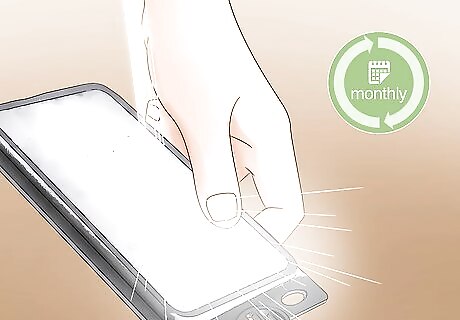
Change or clean the filter about once a month. Rinse mechanical filtration regularly with tank water from a siphon or a bucket if you are concerned about losing bacterial colonies. Remove and replace chemical media (like carbon, GFO, or Chemi-Pure) every 2-6 weeks, depending on the load and maintenance regimen.
Saltwater Aquariums
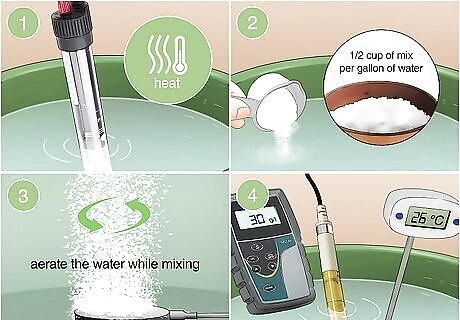
Mix a saltwater solution. It's essential that the temperature, salinity, and pH of the water are all within an acceptable range for your fish. Start this process the night before you clean your tank. Buy distilled or reverse osmosis water from the grocery store. Place the water in a clean plastic bucket, preferably used only for this purpose. Heat the water with a specialized heater, purchased at a pet store. Add the salt mix. One-step salt mixes are available at pet stores. Follow the instructions on how much to add based on how much water you are using. The rule of thumb is 1/2 cup of mix for every 1 gallon of water. Aerate the water while mixing in the salt. In the morning, check the salinity with a refractometer, hygrometer, or salinity probe. In fish-only systems, you can shoot for a salinity of 30 grams per liter (g/L) as a baseline. In some cases, such as if you have corals in your tank, you may need to mix the salt to seawater concentration which is 35 g/L. Check the temperature with a thermometer. For saltwater fish, it should be between 73–82 °F (23–28 °C).
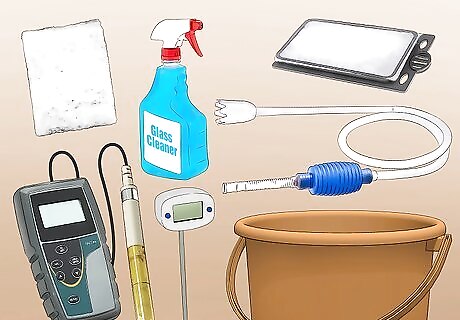
Get your cleaning supplies ready. Saltwater aquariums have special needs in addition to the basic supplies you'd use for a freshwater aquarium. Gather the following supplies: An algae pad for cleaning the glass inside the tank. A 5 US gal (19 L) bucket dedicated for this purpose. A simple siphon-type gravel vacuum (NOT a battery-operated gadget). Filter media (cartridges, sponges, carbon packets, and so on) if you're changing the filter this time. Aquarium-safe glass cleaner or a vinegar-based solution. pH strips. A refractometer, hygrometer, or salinity probe. A thermometer. 10% bleach solution in a separate container (optional)
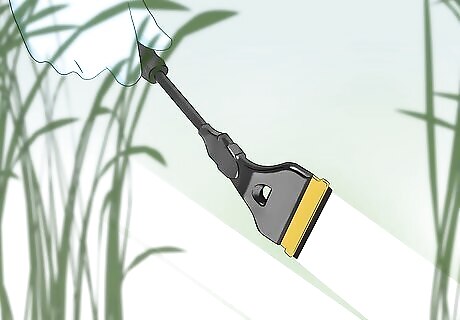
Clean off the algae. Use the algae pad to remove algae residue from the inside of the tank. Use a razor blade or plastic blade to scrape off built-up residue that's difficult to remove.
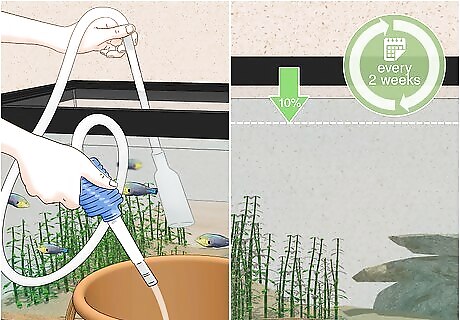
Siphon out the water. For a saltwater aquarium, change 10% of the water every 2 weeks. For most systems, this should be sufficient to eliminate nitrates from the water. Start the siphon and let the water run into a large bucket.

Clean the gravel. Push the gravel vacuum through the gravel. Fish waste, excess food, and other debris will be sucked into the vacuum. If you have very small, weak, or delicate fish, you can put a fish net over the end of the siphon. Lower the flow rate by putting your finger over the end of the siphon or kinking the hose if you have sand substrate. Hold the hose 1 inch (2.5 cm) or less from the surface and use it suck up waste without disturbing the sand. Stir the sand to prevent the formation of anaerobic zones.

Clean the decorations. Wipe the decorations off with an algae pad or a never-used soft-bristled toothbrush in the tank water you siphoned out. You can also remove the decorations from the tank and soak the items in a 10% bleach solution for 15 minutes. Then rinse the decorations and treat them with dechlor.
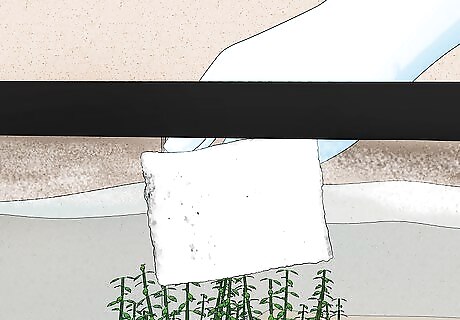
Check for salt creep. When the salt water evaporates at the top of the aquarium, it will leave behind a crusty residue known as salt creep. Clean it off with an algae sponge or wet towel and add back the lost water.
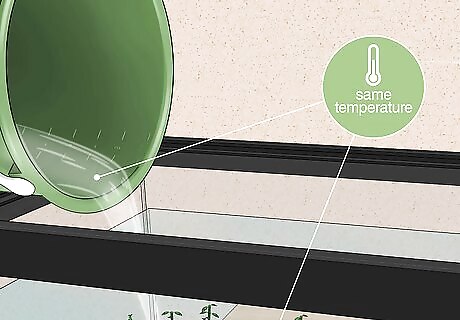
Add the water to the tank. Carefully pour the premixed water into the tank. Again, be sure the salinity and temperature match the water already in the tank. Avoid overfilling the tank.
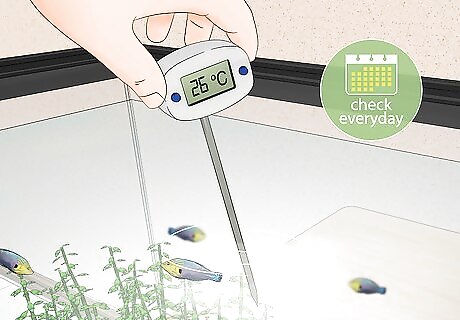
Check the temperatures every day. Saltwater fish live in a relatively narrow temperature range. To make sure they're healthy, you'll want to check the temperature of the aquarium on a daily basis.

















Comments
0 comment